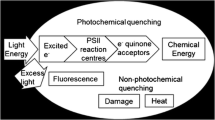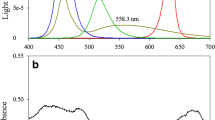Abstract
The productivity was evaluated of a strain of Chlamydomonas perigranulata isolated from the RedSea. A mutant with small light-harvesting pigments(LHC-1) was obtained by UV mutagenesis. Thechlorophylls content of the wild type was twice ashigh as that of LHC-1, and the initial slope of thephotosynthesis-irradiance curve was higher in the wildtype. However, the maximum photosynthetic activity ona per cell basis was almost the same. It isconcluded that LHC-1 is a mutant with lesslight-harvesting pigment (LHP) than the wild type. Aspreviously reported, the mutant with lower LHP contenthas a higher productivity in a continuous culturesystem, so we compared the productivity of the wildtype and the mutant. The maximum productivity of LHC-1was 1.5 times higher than that of the wild type. Itis suggested that the technique of reducing thecontent of light-harvesting pigment should be madeavailable for other organisms.
Similar content being viewed by others
References
Benemann JR (1989) The future of microalgal biotechnology. In Cresswell RC, Rees TAV, Shah N (eds), Algal and Cyanobacterial Biotechnology, Longman Scientific & Technical, Harlow, UK, pp. 317-337.
Chua NH, Bennoun P (1975) Thylakoid membrane polypeptides of Chlamydomonas reinhardtii wild-type and mutant strain deficient in photosystem II reaction center. Proc. natl Acad. Sci. 72: 2175-2179.
Fujita Y, Murakami A (1987) Regulation of electron transport composition in cyanobacterial photosynthetic system: Stoichiometry among PSI and PSII complexs and their light harvesting antenna and Cyt b 6-f complex. Plant Cell Physiol. 28: 1547-1553.
MacKinney G (1941) Absorption of light by chlorophyll solutions. J. biol. Chem. 140: 315-322.
Mauzerall D, Greenbaum NC (1989) The absolute size of a photosynthetic unit. Biochem. Biophys. Acta 974: 119-140.
Melis A, Neidhardt J, Benemann JR (1999) Dunaliella salina (Chlorophyta) with small chlorophyll antenna sizes exhibit higher photosynthetic productivities and photon use efficiencies than normally pigmented cells. J. appl. Phycol. 10: 515-525.
Nakajima Y, Tsuzuki M, Ueda R (1998) Reduced photoinhibition of a phycocyanin deficient mutant of Synechocystis PCC6714. J. appl. Phycol. 10: 447-452.
Nakajima Y, Ueda R (1997) Improvement of photosynthesis in dense microalgal suspension by reduction of light harvesting pigments. J. appl. Phycol. 9: 503-510.
Nakajima Y, Ueda R (1999) Improvement of microalgal photosynthetic productivity by reducing the content of light harvesting pigment. J. appl. Phycol. 11: 195-201.
Author information
Authors and Affiliations
Rights and permissions
About this article
Cite this article
Nakajima, Y., Ueda, R. The effect of reducing light-harvesting pigment on marine microalgal productivity. Journal of Applied Phycology 12, 285–290 (2000). https://doi.org/10.1023/A:1008108500409
Issue Date:
DOI: https://doi.org/10.1023/A:1008108500409




